Assessment of Hamstring: Quadriceps Coactivation without the Use of Maximum Voluntary Isometric Contraction
Abstract
Featured Application
Abstract
1. Introduction
2. Materials and Methods
2.1. Ethical Considerations
2.2. Participants
2.3. Study Design
- Lunge. Prior to the start of the exercise, the position of reference (Figure 1) was determined, and the distance between the feet of each player was measured and marked on the ground with adhesive tape. To detect this position, the subject was placed in the reference position in such a way that the knee and hip of the forward leg and the delayed leg were at 90 degrees using the Lafayette Gollehon goniometer (Lafayette Instrument Company, Lafayette, IN, USA). The starting position was leg forward in contact with the ground and knee extended and back leg in contact with the ground and knee extended, with a straight trunk and looking forward. From the starting position, the subject had to bend the knees to lower the body, keeping the trunk straight. Once down, after two seconds the subject started the ascension phase extending both knees until the initial position with both feet in contact with the ground and knees extended. It was ensured that the knee of the advanced leg did not surpass the toe of the foot [7].
2.4. Procedure
2.5. Data Processing
2.6. Statistical Analysis
3. Results
3.1. Inter-Limb Effect
3.2. Intra-Muscular Group Activation Pattern
3.3. Electrical Activation During the Movement Phases
4. Discussion
5. Conclusions
Author Contributions
Funding
Conflicts of Interest
References
- Philippaerts, R.M.; Vaeyens, R.; Janssens, M.; Van Renterghem, B.; Matthys, D.; Craen, R.; Bourgois, J.; Vrijens, J.; Beunen, G.; Malina, R. The relationship between peak height velocity and physical performance in youth soccer players. J. Sports Sci. 2006, 24, 221–230. [Google Scholar] [CrossRef] [PubMed]
- Di Salvo, V.; Baron, R.; Tschan, H.; Montero, F.C.; Bachl, N.; Pigozzi, F. Performance characteristics according to playing position in elite soccer. Int. J. Sports Med. 2007, 28, 222–227. [Google Scholar] [CrossRef] [PubMed]
- Daneshjoo, A.; Rahnama, N.; Mokhtar, A.H.; Yusof, A. Effectiveness of injury prevention programs on developing quadriceps and hamstrings strength of young male professional soccer players. J. Hum. Kinet. 2013, 39, 115–125. [Google Scholar] [CrossRef] [PubMed]
- Evangelidis, P.E.; Pain, M.T.; Folland, J. Angle-specific hamstring-to-quadriceps ratio: A comparison of football players and recreationally active males. J. Sports Sci. 2015, 33, 309–319. [Google Scholar] [CrossRef]
- Houweling, T.A.; Head, A.; Hamzeh, M.A. Validity of isokinetic testing for previous hamstring injury detection in soccer players. Isokinet. Exerc. Sci. 2009, 17, 213–220. [Google Scholar] [CrossRef]
- Kannus, P. Isokinetic evaluation of muscular performance. Int. J. Sports Med. 1994, 15, S11–S18. [Google Scholar] [CrossRef]
- Begalle, R.L.; DiStefano, L.J.; Blackburn, T.; Padua, D.A. Quadriceps and Hamstrings Coactivation during Common Therapeutic Exercises. J. Athl. Train. 2012, 47, 396–405. [Google Scholar] [CrossRef]
- Dedinsky, R.; Baker, L.; Imbus, S.; Bowman, M.; Murray, L. Exercises that facilitate optimal hamstring and quadriceps co-activation to help decrease acl injury risk in healthy females: A systematic review of the literature. Int. J. Sports Phys. Ther. 2017, 12, 3. [Google Scholar]
- Ebben, W. Hamstring activation during lower body resistance training exercises. Int. J. Sports Physiol. Perform. 2009, 4, 84–96. [Google Scholar] [CrossRef]
- Duhig, S.J.; Williams, M.D.; Minett, G.M.; Opar, D.; Shield, A.J. Drop punt kicking induces eccentric knee flexor weakness associated with reductions in hamstring electromyographic activity. J. Sci. Med. Sport 2017, 20, 595–599. [Google Scholar] [CrossRef][Green Version]
- Rouissi, M.; Chtara, M.; Owen, A.; Chaalali, A.; Chaouachi, A.; Gabbett, T.; Chamari, K. Effect of leg dominance on change of direction ability amongst young elite soccer players. J. Sports Sci. 2016, 34, 542–548. [Google Scholar] [CrossRef] [PubMed]
- Cortis, C.; Tessitore, A.; Perroni, F.; Lupo, C.; Pesce, C.; Ammendolia, A.; Capranica, L. Interlimb coordination, strength, and power in soccer players across the lifespan. J. Strength Cond. Res. 2009, 23, 2458–2466. [Google Scholar] [CrossRef] [PubMed]
- Navandar, A.; Veiga, S.; Torres, G.; Chorro, D.; Navarro, E. A previous hamstring injury affects kicking mechanics in soccer players. J. Sports Med. Phys. Fit. 2018, 58, 1815–1822. [Google Scholar] [CrossRef] [PubMed]
- Daneshjoo, A.; Rahnama, N.; Mokhtar, A.H.; Yusof, A. Bilateral and unilateral asymmetries of isokinetic strength and flexibility in male young professional soccer players. J. Hum. Kinet. 2013, 36, 45–53. [Google Scholar] [CrossRef] [PubMed]
- Montini, M.; Felici, F.; Nicolo, A.; Sacchetti, M.; Bazzucchi, L. Neuromuscular demand in a soccer match assessed by a continuous electromyographic recording. J. Sports Med. Phys. Fit. 2017, 57, 345–352. [Google Scholar]
- LaPrade, R.F.; Surowiec, R.K.; Sochanska, A.N.; Hentkowski, B.S.; Martin, B.M.; Engebretsen, L.; Wijdicks, C.A. Epidemiology, identification, treatment and return to play of musculoskeletal-based ice hockey injuries. Br. J. Sports Med. 2014, 48, 4–10. [Google Scholar] [CrossRef]
- Farrokhi, S.; Pollard, C.D.; Souza, R.B.; Chen, Y.-J.; Reischl, S.; Powers, C.M. Trunk position influences the kinematics, kinetics, and muscle activity of the lead lower extremity during the forward lunge exercise. J. Orthop. Sports Phys. Ther. 2008, 38, 403–409. [Google Scholar] [CrossRef]
- Pincivero, D.M.; Aldworth, C.; Dickerson, T.; Petry, C.; Shultz, T. Quadriceps-hamstring EMG activity during functional, closed kinetic chain exercise to fatigue. Eur. J. Appl. Physiol. 2000, 81, 504–509. [Google Scholar] [CrossRef]
- Boudreau, S.N.; Dwyer, M.K.; Mattachola, C.G.; Lattermann, C.; Uhl, T.L.; McKeon, J.M. Hip-muscle activation during the lunge, single-leg squat, and step-up-and-over exercises. J. Sport Rehabil. 2009, 18, 91–103. [Google Scholar] [CrossRef]
- Caterisano, A.; Moss, R.E.; Pellinger, T.K.; Woodruff, K.; Lewis, V.C.; Booth, W.; Khadra, T. The effect of back squat depth on the EMG activity of 4 superficial hip and thigh muscles. J. Strength Cond. Res. 2002, 16, 428–432. [Google Scholar]
- McCurdy, K.; O´Kelley, E.; Kutz, M.; Langford, G.; Ernest, J.; Torres, M. Comparison of lower extremity EMG between the 2-leg squat and modified single-leg squat in female athletes. J. Sport Rehabil. 2010, 19, 57–70. [Google Scholar] [CrossRef] [PubMed]
- Ekstrand, J.; Hägglund, M.; Waldén, M. Injury incidence and injury patterns in professional football: The UEFA injury study. Br. J. Sports Med. 2011, 45, 553–558. [Google Scholar] [CrossRef] [PubMed]
- Ekstrand, J.; Waldén, M.; Hägglund, M. Hamstring injuries have increased by 4% annually in men’s professional football, since 2001: A 13-year longitudinal analysis of the UEFA Elite Club injury study. Br. J. Sports Med. 2016, 50, 731–737. [Google Scholar] [CrossRef] [PubMed]
- Croisier, J.-L. Factors associated with recurrent hamstring injuries. Sports Med. 2004, 34, 681–695. [Google Scholar] [CrossRef]
- Fousekis, K.; Tsepis, E.; Poulmedis, P.; Athanasopoulos, S.; Vagenas, G. Intrinsic risk factors of non-contact quadriceps and hamstring strains in soccer: A prospective study of 100 professional players. Br. J. Sports Med. 2011, 45, 709–714. [Google Scholar] [CrossRef]
- Aagaard, P.; Simonsen, E.B.; Andersen, J.L.; Magnusson, S.P.; Bojsen-Moller, F.; Dyhre-Poulse, P. Antagonist muscle coactivation during isokinetic knee extension. Scand. J. Med. Sci. Sports 2000, 10, 58. [Google Scholar] [CrossRef]
- Beyer, K.S.; Fukuda, D.; Miramonti, A.M.; Church, D.; Tanigawa, S.; Stout, J.R.; Hoffman, J.R. Strength ratios are affected by years of experience in American collegiate rugby athletes: A preliminary study. Isokinet. Exerc. Sci. 2016, 24, 257–262. [Google Scholar] [CrossRef]
- Van der Horst, N.; Smits, D.; Petersen, J.; Goedhart, E.A.; Backx, F. The preventive effect of the Nordic hamstring exercise on hamstring injuries in amateur soccer players: A randomized controlled trial. Am. J. Sports Med. 2015, 43, 1316–1323. [Google Scholar] [CrossRef]
- Bourne, M.N.; Williams, M.D.; Opar, D.; Al Najjar, A.; Kerr, G.K.; Shield, A.J. Impact of exercise selection on hamstring muscle activation. Br. J. Sports Med. 2017, 51, 1021–1028. [Google Scholar] [CrossRef]
- Guex, K.; Millet, G.P. Conceptual framework for strengthening exercises to prevent hamstring strains. Sports Med. 2013, 43, 1207–1215. [Google Scholar] [CrossRef]
- Brukner, P. Hamstring injuries: Prevention and treatment—An update. Br. J. Sports Med. 2015, 49, 1241–1244. [Google Scholar] [CrossRef] [PubMed]
- Heckmann, T.P.; Noyes, F.R.; Barber-Westin, S. Rehabilitation after ACL reconstruction. In ACL Injuries in the Female Athlete; Springer: Berlin/Heidelberg, Germany, 2018; pp. 505–535. [Google Scholar]
- Irish, S.E.; Millward, A.J.; Wride, J.; Haas, B.M.; Shum, G.L. The effect of closed-kinetic chain exercises and open-kinetic chain exercise on the muscle activity of vastus medialis oblique and vastus lateralis. J. Strength Cond. Res. 2010, 24, 1256–1262. [Google Scholar] [CrossRef] [PubMed]
- Charlton, P.C.; Drew, M.K.; Mentiplay, B.F.; Grimaldi, A.; Clark, R.A. Exercise interventions for the prevention and treatment of groin pain and injury in athletes: A critical and systematic review. Sports Med. 2017, 47, 2011–2026. [Google Scholar] [CrossRef] [PubMed]
- Robertson, D.; Dowling, J. Design and responses of Butterworth and critically damped digital filters. J. Electromyogr. Kinesiol. 2003, 13, 569–573. [Google Scholar] [CrossRef]
- Marras, W.S.; Davis, K.G. A non-MVC EMG normalization technique for the trunk musculature: Part 1. Method development. J. Electromyogr. Kinesiol. 2001, 11, 1–9. [Google Scholar] [CrossRef]
- Suydam, S.M.; Manal, K.; Buchanan, T.S. The advantages of normalizing electromyography to ballistic rather than isometric or isokinetic tasks. J. Appl. Biomech. 2017, 33, 189–196. [Google Scholar] [CrossRef]
- Andersen, V.; Fimland, M.S.; Brennset, O.; Haslestad, L.R.; Lundteigen, M.S.; Skalleberg, K.; Saeterbakken, A.H. Muscle activation and strength in squat and bulgarian squat on stable and unstable surface. Int. J. Sports Med. 2014, 35, 1196–1202. [Google Scholar] [CrossRef]
- Chiu, L.Z.; Burkhardt, E. A teaching progression for squatting exercises. Strength Cond. J. 2011, 33, 46–54. [Google Scholar] [CrossRef]
- Herman, K.; Barton, C.; Malliaras, P.; Morrissey, D. The effectiveness of neuromuscular warm-up strategies, that require no additional equipment, for preventing lower limb injuries during sports participation: A systematic review. BMC Med. 2012, 10, 75. [Google Scholar] [CrossRef]
- Hermens, H.J.; Freriks, B.; Disselhorst-Klug, C.; Rau, G. Development of recommendations for SEMG sensors and sensor placement procedures. J. Electromyogr. Kinesiol. 2000, 10, 361–374. [Google Scholar] [CrossRef]
- Ramírez, A.; Garzón, D.A. Análisis de sensibilidad por la colocación de los electrodos en la electromiografía de superficie (semg). Rev. Fac. Ing. 2013, 46, 70–79. [Google Scholar]
- De Luca, C.; Gilmore, L.D.; Kuznetsov, M.; Roy, S.H. Filtering the surface EMG signal: Movement artifact and baseline noise contamination. J. Biomech. 2010, 43, 1573–1579. [Google Scholar] [CrossRef] [PubMed]
- Fukuda, T.Y.; Echeimberg, J.O.; Pompeu, J.E.; Lucareli, P.; Garbelotti, S.; Gimenes, R.O.; Ampolinario, A. Root mean square value of the electromyographic signal in the isometric torque of the quadriceps, hamstrings and brachial biceps muscles in female subjects. J. Appl. Res. 2010, 10, 32–39. [Google Scholar]
- Yoo, W. Comparison of hamstring-to-quadriceps ratio between accelerating and decelerating sections during squat exercise. J. Phys. Ther. Sci. 2016, 28, 2468–2469. [Google Scholar] [CrossRef] [PubMed]
- Hoshikawa, Y.; Lida, T.; Murumatssu, M.; Nakajima, Y.; Fukunaga, T.; Kanehisa, H. Differences in thigh muscularity and dynamic torque between junior and senior soccer players. J. Sports Sci. 2009, 27, 129–138. [Google Scholar] [CrossRef] [PubMed]
- Zakas, A. Bilateral isokinetic peak torque of quadriceps and hamstring muscles in professional soccer players with dominance on one or both two sides. J. Sports Med. Phys. Fit. 2006, 46, 28. [Google Scholar]
- Fousekis, K.; Tsepis, E.; Vagenas, G. Lower limb strength in professional soccer players: Profile, asymmetry, and training age. J. Sports Sci. Med. 2010, 9, 364–373. [Google Scholar]
- Schwanbeck, S.; Chilibeck, P.D.; Binsted, G. A comparison of free weight squat to Smith machine squat using electromyography. J. Strength Cond. Res. 2009, 23, 2588–2591. [Google Scholar] [CrossRef]
- Housh, T.J.; deVries, H.A.; Johnson, G.O.; Housh, D.J.; Evans, S.A.; Stout, J.R.; Evetovich, T.K.; Bradway, R.M. Electromyographic fatigue thresholds of the superficial muscles of the quadriceps femoris. Eur. J. Appl. Physiol. Occup. Physiol. 1995, 71, 131–136. [Google Scholar] [CrossRef]
- Crossley, K.; Bennell, K.; Green, S.; MaConnell, J. A systematic review of physical interventions for patellofemoral pain syndrome. Clinical J. Sport Med. 2001, 11, 103–110. [Google Scholar] [CrossRef]
- Ninos, J.C.; Irrgang, J.J.; Burdett, R.; Weiss, J.R. Electromyographic analysis of the squat performed in self-selected lower extremity neutral rotation and 30 of lower extremity turn-out from the self-selected neutral position. J. Orthop. Sports Phys. Ther. 1997, 25, 307–315. [Google Scholar] [CrossRef] [PubMed][Green Version]
- Wright, G.; Delong, T.; Gehlsen, G. Electromyographic Activity of the Hamstrings during Performance of the Leg Curl, Stiff-Leg Deadlift, and Back Squat Movements. J. Strength Cond. Res. 1999, 13, 168–174. [Google Scholar]
- Schuermans, J.; Van Tiggelen, D.; Danneels, L.; Witvrouw, E. Biceps femoris and semitendinosus—teammates or competitors? New insights into hamstring injury mechanisms in male football players: A muscle functional MRI study. B. J. Sports Med. 2014, 48, 1599–1606. [Google Scholar] [CrossRef] [PubMed]
- Thelen, D.G.; Chumanov, E.S.; Sherry, M.A.; Heiderscheit, B.C. Neuromusculoskeletal models provide insights into the mechanisms and rehabilitation of hamstring strains. Exerc. Sport Sci. Rev. 2006, 34, 135–141. [Google Scholar] [CrossRef] [PubMed]
- Coombs, R.; Garbutt, G. Developments in the use of the hamstring/quadriceps ratio for the assessment of muscle balance. J. Sports Sci. Med. 2002, 1, 56–62. [Google Scholar]
- Ebben, W.E.; Jensen, R.L. Electromyographic and kinetic analysis of traditional, chain, and elastic band squats. J. Strength Cond. Res. 2002, 16, 547–550. [Google Scholar]
- Yavuz, H.U.; Erdag, D.; Amca, A.M.; Aritan, S. Kinematic and EMG activities during front and back squat variations in maximum loads. J. Sports Sci. 2015, 33, 1058–1066. [Google Scholar] [CrossRef]
- Pincivero, D.M.; Gandhi, V.; Timmons, M.K.; Coelho, A.J. Quadriceps femoris electromyogram during concentric, isometric and eccentric phases of fatiguing dynamic knee extensions. J. Biomech. 2006, 39, 246–254. [Google Scholar] [CrossRef]
- Nardone, A.; Romano, C.; Schieppati, M. Selective recruitment of high-threshold human motor units during voluntary isotonic lengthening of active muscles. J. Physiol. 1989, 409, 451–471. [Google Scholar] [CrossRef]
- Laidlaw, D.H.; Bilodeau, M.; Enoka, R.M. Steadiness is reduced and motor unit discharge is more variable in old adults. Muscle Nerve Off. J. Am. Assoc. Electrodiagn. Med. 2000, 23, 600–612. [Google Scholar] [CrossRef]
- Behm, D.G.; Anderson, K.; Curnew, R.S. Muscle force and activation under stable and unstable conditions. J. Strength Cond. Res. 2002, 16, 416–422. [Google Scholar] [PubMed]
- Jönhagen, S.; Halvorsen, K.; Benoit, D.L. Muscle activation and length changes during two lunge exercises: Implications for rehabilitation. Scand. J. Med. Sci. Sports 2009, 19, 561–568. [Google Scholar] [CrossRef] [PubMed]
- Heiderscheit, B.C.; Sherry, M.A.; Silder, A.; Chumanov, E.S.; Thelen, D.G. Hamstring strain injuries: Recommendations for diagnosis, rehabilitation, and injury prevention. J. Orthop. Sports Phys. Ther. 2010, 40, 67–81. [Google Scholar] [CrossRef] [PubMed]
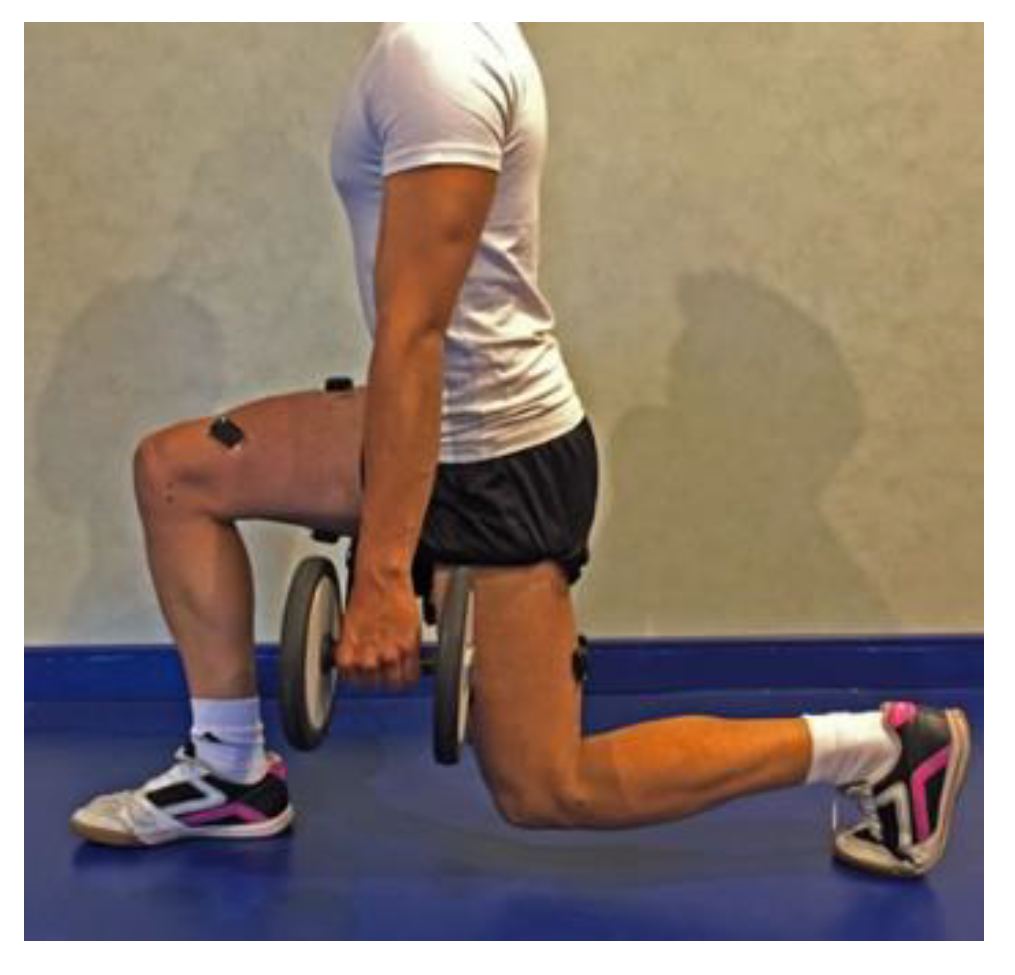
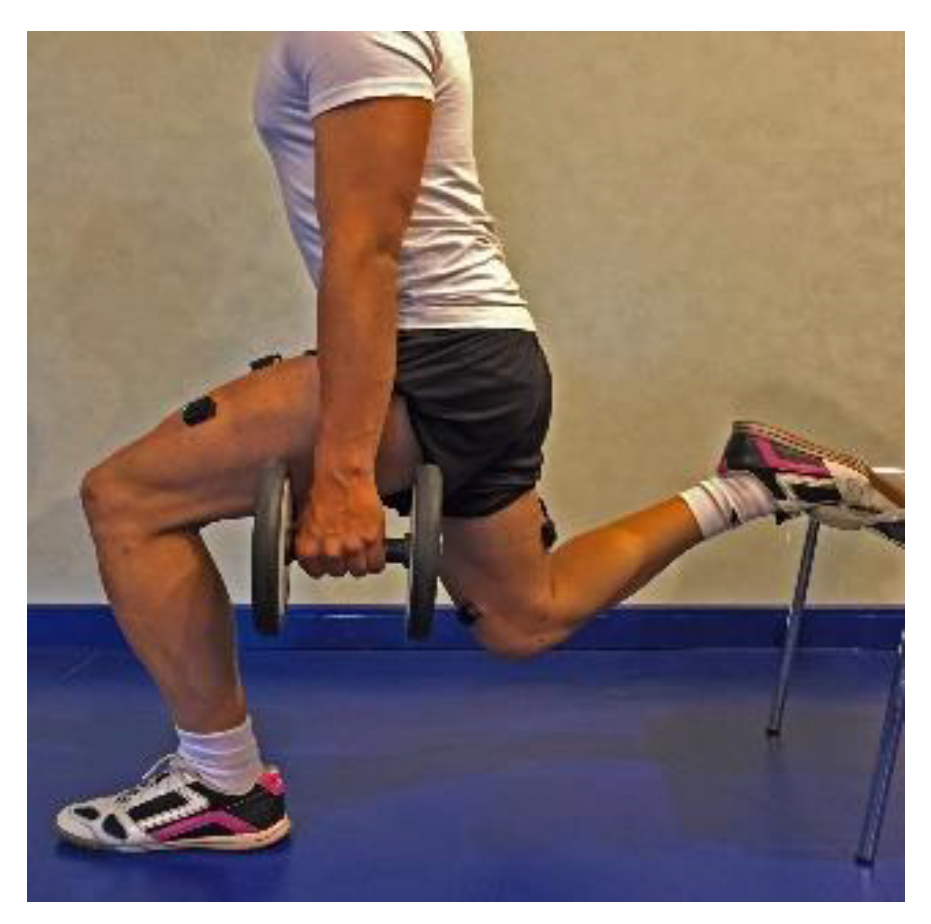
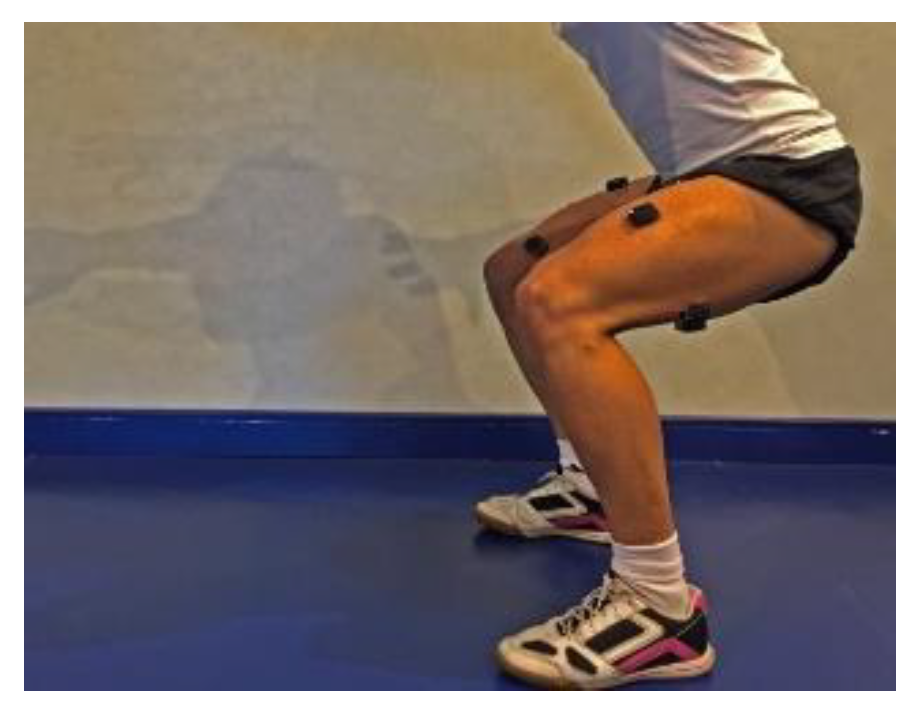
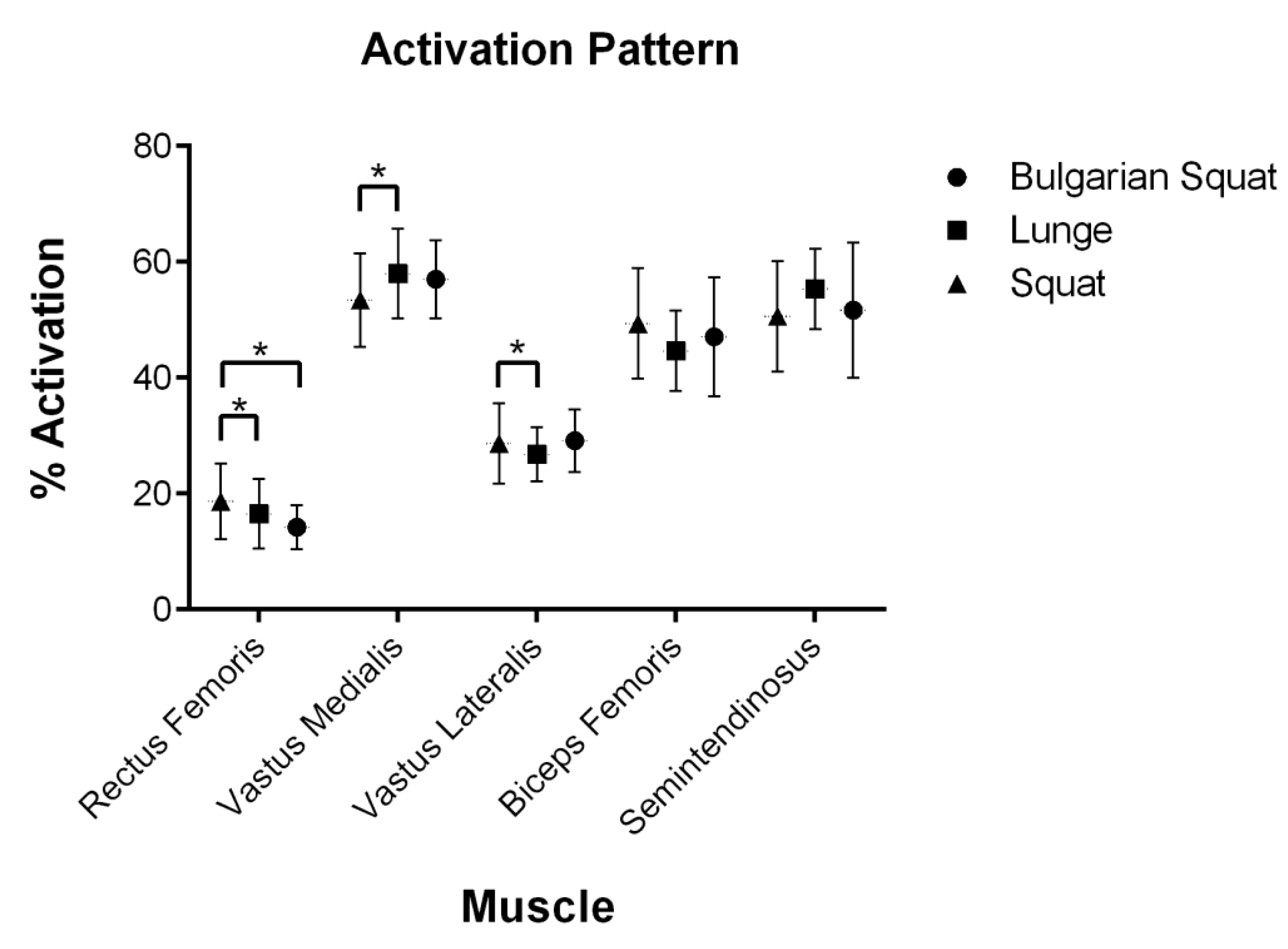

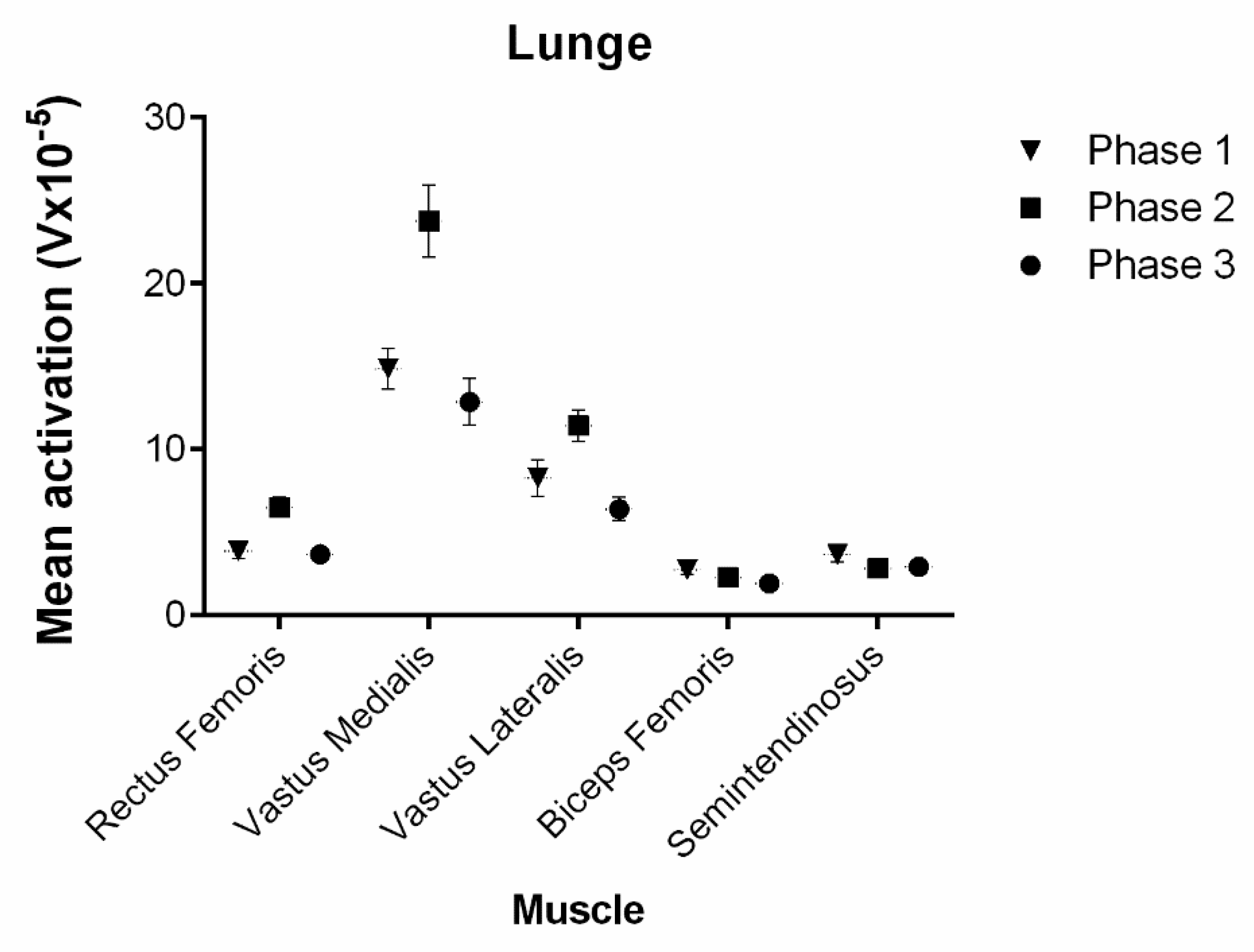
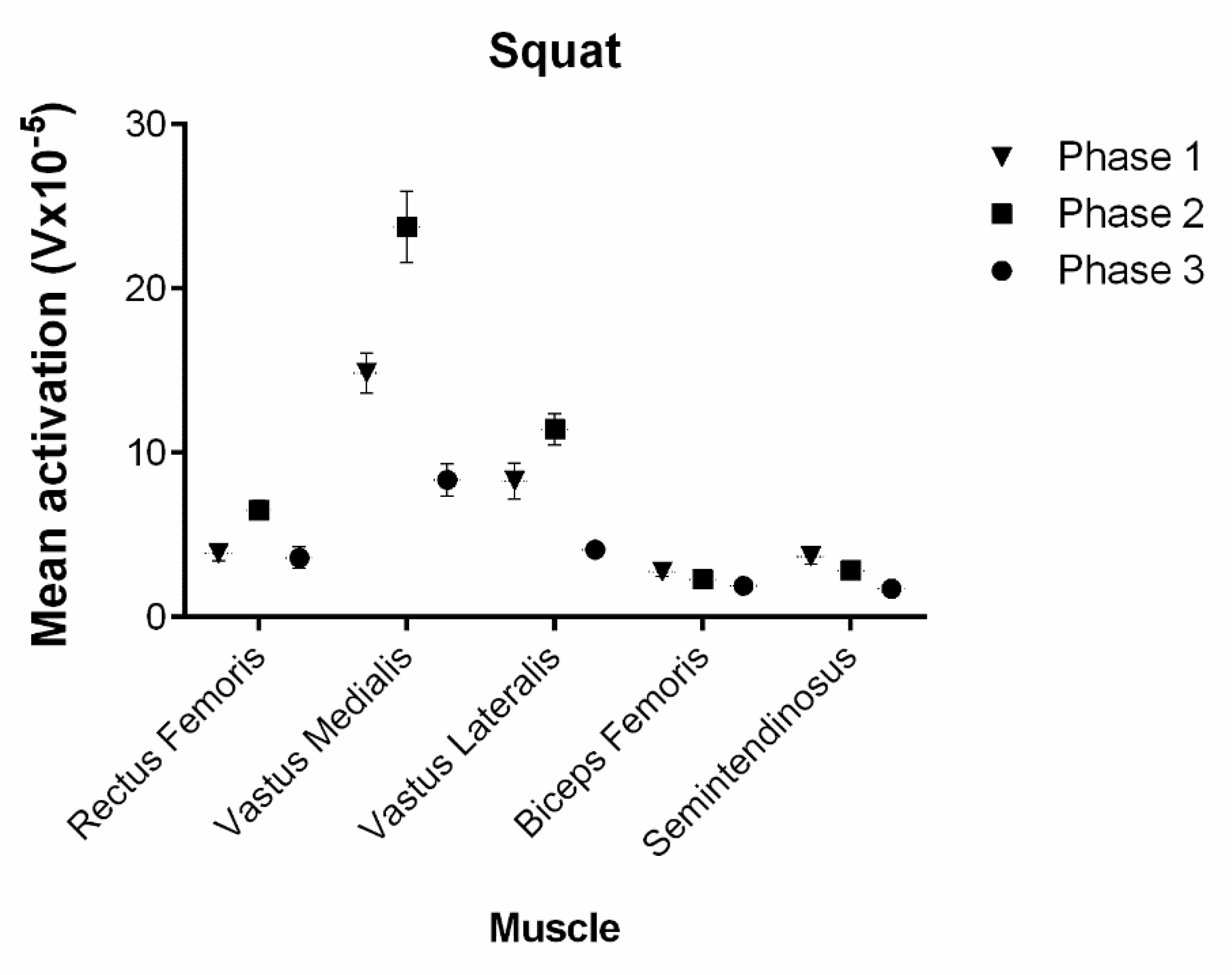
| Muscle | Bulgarian Squat (N = 19) | Lunge (N = 19) | Squat (N = 19) | ||||||
|---|---|---|---|---|---|---|---|---|---|
| Mean ± SD | CI 95% | Mean ± SD | CI 95% | Mean ± SD | CI 95% | ||||
| RF | 14.83 ± 4.50% * | 12.66 | 17.00 | 16.56 ± 5.70% * | 13.81 | 19.31 | 18.69 ± 6.54% * | 15.54 | 21.84 |
| VM | 56.35 ± 6.71% * | 53.12 | 59.58 | 58.85 ± 8.02% * | 54.98 | 62.72 | 53.41 ± 8.03% * | 49.54 | 57.28 |
| VL | 29.17 ± 5.19% * | 26.67 | 31.67 | 25.71 ± 6.10% * | 22.77 | 28.65 | 28.67 ± 6.90% * | 25.34 | 32.00 |
| BF | 47.50 ± 10% * | 42.68 | 52.32 | 44.35 ± 6.93% * | 41.01 | 47.69 | 49.37 ± 9.50% | 44.79 | 53.95 |
| ST | 51.43 ± 11.22% * | 46.02 | 56.84 | 55.65 ± 6.94% * | 52.31 | 58.99 | 50.63 ± 9.50% | 46.05 | 55.21 |
© 2020 by the authors. Licensee MDPI, Basel, Switzerland. This article is an open access article distributed under the terms and conditions of the Creative Commons Attribution (CC BY) license (http://creativecommons.org/licenses/by/4.0/).
Share and Cite
Torres, G.; Chorro, D.; Navandar, A.; Rueda, J.; Fernández, L.; Navarro, E. Assessment of Hamstring: Quadriceps Coactivation without the Use of Maximum Voluntary Isometric Contraction. Appl. Sci. 2020, 10, 1615. https://doi.org/10.3390/app10051615
Torres G, Chorro D, Navandar A, Rueda J, Fernández L, Navarro E. Assessment of Hamstring: Quadriceps Coactivation without the Use of Maximum Voluntary Isometric Contraction. Applied Sciences. 2020; 10(5):1615. https://doi.org/10.3390/app10051615
Chicago/Turabian StyleTorres, Gonzalo, David Chorro, Archit Navandar, Javier Rueda, Luís Fernández, and Enrique Navarro. 2020. "Assessment of Hamstring: Quadriceps Coactivation without the Use of Maximum Voluntary Isometric Contraction" Applied Sciences 10, no. 5: 1615. https://doi.org/10.3390/app10051615
APA StyleTorres, G., Chorro, D., Navandar, A., Rueda, J., Fernández, L., & Navarro, E. (2020). Assessment of Hamstring: Quadriceps Coactivation without the Use of Maximum Voluntary Isometric Contraction. Applied Sciences, 10(5), 1615. https://doi.org/10.3390/app10051615








